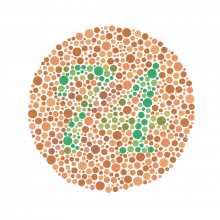Why might a person not be able to see coloured ink on a whiteboard?
Why might a person, who apparently isn't colour-blind, not be able to see red or green on a whiteboard? What is colour-blindness anyway? We try to find the answer in this Question of the Week. Plus, we ask which is worse for the environment - a few weeks of volcanic eruption or a few weeks of aviation.
In this episode

00:00 - Why can't he see red or green ink on a whiteboard?
Why can't he see red or green ink on a whiteboard?
We put this question to Petroc Sumner of Cardiff University...
To answer the question about the pens on the whiteboard, basically, this doesn't sound to me like a simple case of red, green colour blindness, but it might be a case of red, green colour blindness combined with something else. Basically, in the eye, we have two types of receptor called rods and cones. The rods do night time vision when things are relatively dark and the cones do daytime vision. It's often a misnomer that cones only do colour vision, but they also do light and dark vision during the day when the rods are not active. If you are red/green colour blind, it means that you don't have one type of cone. But that doesn't mean that you can't distinguish any colours and it also means that you should still be able to distinguish things at different lightness. So for example, yellow and brown or grey and white would still be pretty clearly distinguished for you. And because white on a whiteboard is basically the lightest colour, anything that's coloured is normally darker than white which means that even though you might not be able to tell the difference between the red and the green pens, you should be able to tell the difference between the white board and the red and the green pens, because both of the pens will be darker than the white board. So that's why it doesn't sound like it's just a simple case of red, green colour blindness.
Diana - So distinguishing coloured marks from their background shouldn't be a problem. What else could be going on?
Petroc - Having said that, the green and red pens will be less dark than say, a black or a blue pen would be. You can show this actually by doing a little experiment which I just did myself. I wrote red and green writing on my whiteboard, I shut the curtains, made it as dark as possible in the room, turned the lights out, waited until I was accustomed, and then it's clear to me that even though I've now lost my colour vision because I'm seeing with my rods, and not my cones anymore, I can still see both the red and the green writing. But you should also see that the green is less distinct than the red and the red is less distinct than black writing, and that's because both the coloured pens won't be as dark as the black pen. You can then imagine that if you combined this, not having colour vision with say, not being fully able to see the thin lines. So if you squint at these lines for example, you'll probably see that they disappear or I can get the green one to disappear with some kind of squint at it, and that might be sort of simulating if I wasn't wearing my glasses or if I had some other reason in my eye, that I wasn't so sensitive to contrast or to acuity. So that's why maybe a colour blindness associated with something else could mean that you wouldn't be able to see these pens on a whiteboard. The reason a colour blind person wouldn't be able to see a laser pointer on a whiteboard is because it isn't darker than the whiteboard. A laser pointer is adding light to the whiteboard of course, and so, it isn't darker than the whiteboard. It only differs in colour and that's why a colour blind person would have difficulty seeing the red laser pointer on a whiteboard.
Diana - Colour blindness occurs when certain types of cones in the eyes aren't present, but the person in the question sounds as if he had some cones. Perhaps it's more of an issue with detecting differences in luminosity or the brightness of surfaces.










Comments
Add a comment